Last-Minute NYC Holiday Gift Guide 🎁
We’ve created a holiday gift guide with presents for the intrepid New Yorker that should arrive just in time—


New York City streets are proverbially paved with gold, but in reality, they have been paved with everything from dirt and stone to iron and even wood. At the City Reliquary Museum in Brooklyn, a wooden brick sits atop a shelf in a glass case among an eclectic mix of artifacts that represent life in New York City. The brick was taken from what was believed to be the last wooden sidewalk in New York City. It is a relic of a once innovative and widely used paving system that promised safer and quieter streets.
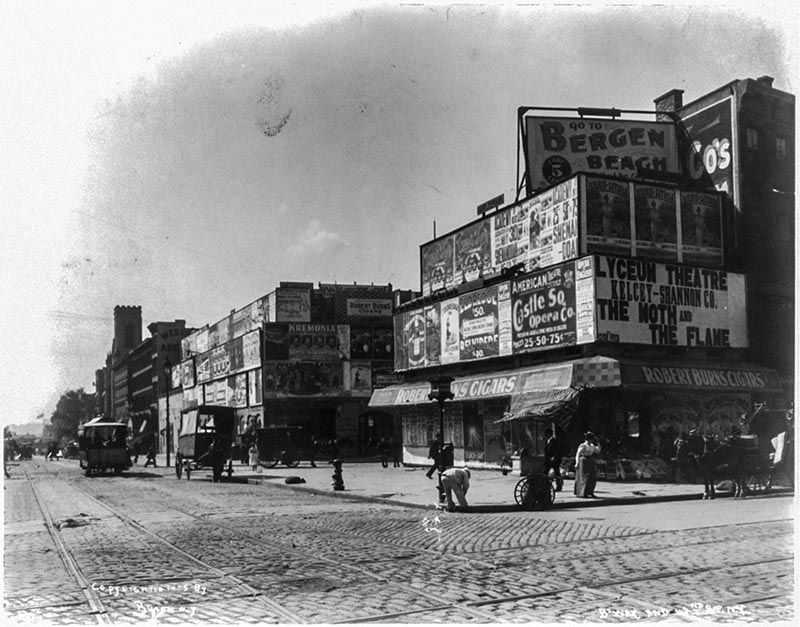
The first street in New York City to be paved with anything but dirt or gravel was Stone Street. Known as Hoogh Straet to the Dutch of New Amsterdam and later as High Street to the British, the road was paved with cobblestones in 1655. According to Untapped New York tour guide, Justin Rivers, who runs our Tour of the Remnants of Dutch New Amsterdam, “a rich Brewer’s wife wanted Peg-leg Pete (Peter Stuyvesant) to pave that street because she lived on it and the dust from the horses was ruining her drapes.”
While cobblestone paving was much cleaner than dirt and gravel, it still had drawbacks. Made of “untooled, naturally rounded stones,” as noted in a 2017 Historic District Council streetscape study, cobblestone streets could be uneven and were loud when carriages and clomping horses traveled over them. By the mid-1800s, cities were looking to replace hard, noisy streets with something easier on the ears, carriage wheels, and horse legs.
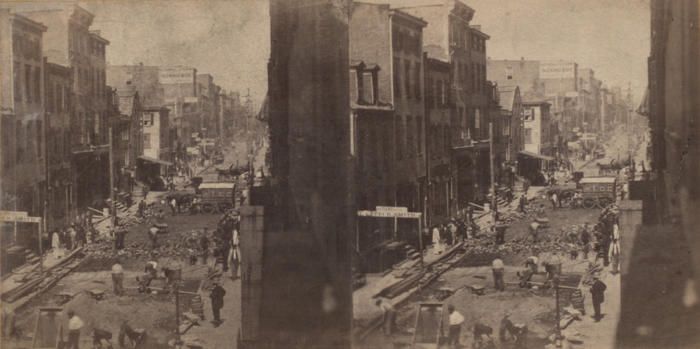
Trying to find a better solution than stone paving methods, Samuel Nicolson laid down 100-feet of experimental wood pavers in Boston in 1848. The stretch of road was divided into four sections where Nicolson experimented with different modifications of what was dubbed Nicolson Pavement. With his new system of wooden sidewalk, Nicolson hoped to provide “safety to travelers, horses, and vehicles; durability; comparative noiselessness; healthfulness as to material used; absence of dust, and exemption from rapidly accumulation and slippery mud.”
After seven years, Nicolson claims the test road “neither received nor required the slightest repair.” The Boston city government commissioned more roads to be paved over with Nicolson’s method, and the technology soon spread to other cities like Chicago and New York. As more streets were paved with wood, Nicolson continued to experiment, changing the blocks’ shapes, what type of wood they were made out of, and what materials he used to fill the spaces in between. The wooden bricks were coated with a thin layer of coal or pine tar to keep out moisture. Other companies also improved upon Nicolson’s original idea. Stow Pavement was one variation used in New York City.

Wood paving came to New York in the 1860s and was widely used throughout the latter half of the 19th-century. By the early 1900s, wooden streets could be found all over New York City, predominantly in the lower part of Manhattan. Streets including lower Broadway, Mercer Street, State Street, Greenwich Street, 24th Street, Rector Street, and Maiden Lane among others, were all paved with wood. Wooden pavement was also used in Brooklyn, primarily on the streets near the borough’s bustling waterfront. In the photograph above, you can see part of a wooden sidewalk from West Street in Greenpoint, a stretch of sidewalk believed to have been the last sample of exposed wooden pavement in New York City.
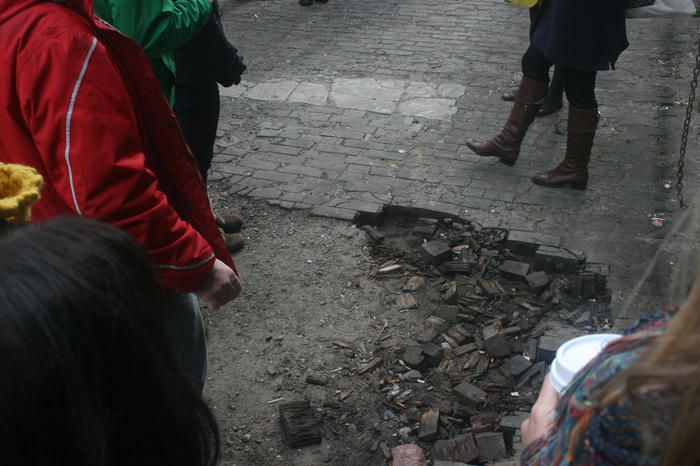
While many New York City residents extolled the benefits of wood paving and requested that it be installed on their streets, the pros and cons were hotly debated. In a Letter to the Editor in the New York Times in 1907, the writer called wood pavement a “curse” and wrote that “of all the pavements ever laid down in this city, the wooden pavement in the lower part of the city is the worst.” On the other hand, a proponent of wooden pavers writing to the New York Times a year earlier said that “not a single street in the whole city could vie with lower Broadway since the completion of this wonderful pavement.”
Wood paving had many benefits over stone paving, but also many of its own problems. One major complaint of stone paving was that dirt and manure often got stuck in the rough surface, causing a foul odor. Wood paving solved the manure problem because its surface was smooth, but because wood is porous, opponents complained that it absorbed horse urine and could get just as smelly. While tar and creosote coatings were meant to help the woodblocks be less absorbent when moisture did get in, they would expand and crack, leading to dangerous holes, or rot, which led to more bad odors. For those concerned about horse safety, the soft and smooth wood pavers were considered more humane than hard and uneven stone streets. However, wood streets could be very slippery. One concerned citizen claimed to have witnessed fifty horses fall on the wood pavement outside his business in one day. In one incident, a stretch of wooden pavement even caught fire, though that was very rare.
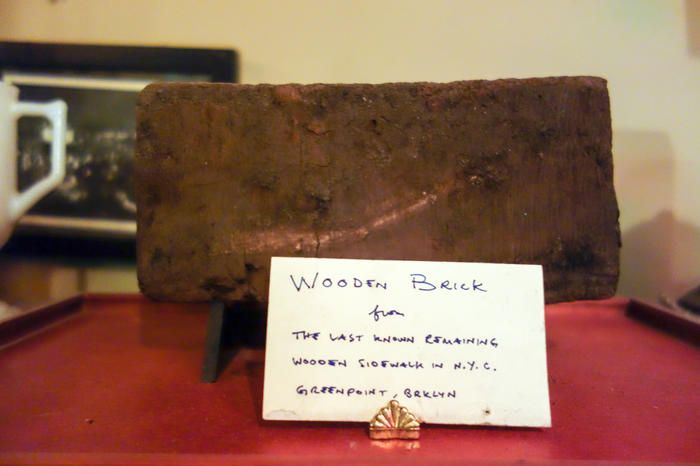
What New Yorkers loved the most about wood pavers was that they were quiet. In one of our previous virtual tours of the City Reliquary Museum (which can be found in our video archive for Insiders), Assistant Director Beth Haines noted that this feature made it desirable for paving outside of hospitals. However, by the start of the 20th century, New York found a paving method that solved all of the problems associated with wood and stone pavers. The new paving material was asphalt. In 1949, there were roughly 140 miles of granite Belgian block in New York City, but by 2017, there were less than 15 miles.
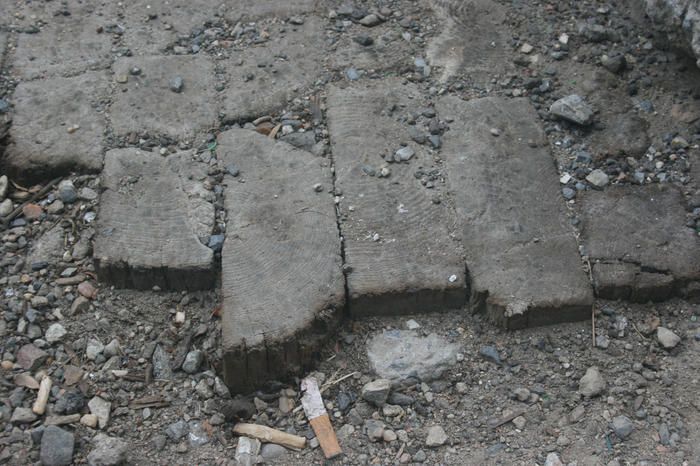
Wood paving was even harder to come by, and the last of it, on a stretch of sidewalk on West Street in Greenpoint, Brooklyn, was covered over in 2015. The wood was paved to make a concrete sidewalk. In the street next to where the sidewalk was paved, you’ll find part of the Brooklyn Greenway, a 26-mile bike path that connects various neighborhoods along the Brooklyn waterfront. Before wood paving completely disappeared, one local Brooklynite was able to grab a block and gift it to the City Reliquary, where it sits today. Visitors can make an appointment to visit the City Reliquary Museum and explore all the treasures within its collection. Wooden pavement can still be found, in small patches, in American cities like St. Louis, Chicago, and Pittsburgh. You can also see a similar type of wood block on Wall Street, part of an installation that denotes the original line of the wooden wall that once stood there in Colonial times.

Uncover more quirky artifacts of NYC on our upcoming virtual tour of the City Reliquary Museum with Assistant Director Beth Haines on February 22nd! Not an Insider yet?
Become a member todayto access all upcoming live events and our video archive of over 150 recorded virtual talks. Even if you can’t watch live, a link to the recording will be sent to all registrants.
Next, check out 160 fascinating secrets of NYC, 10 Fun Facts about NYC’s Belgian Block (Not Cobblestone) Streets and Trace the Original Wall of Wall Street with Wooden Markers Hidden in Plain Sight.
Subscribe to our newsletter